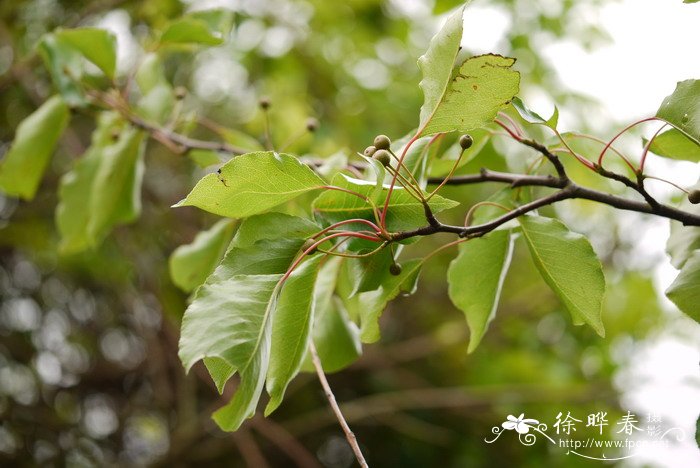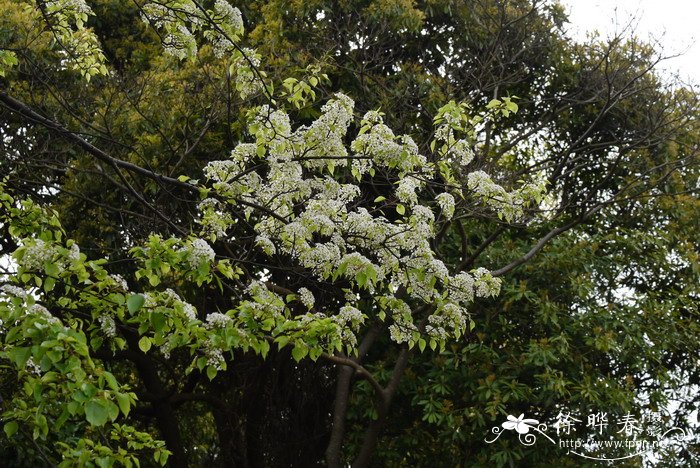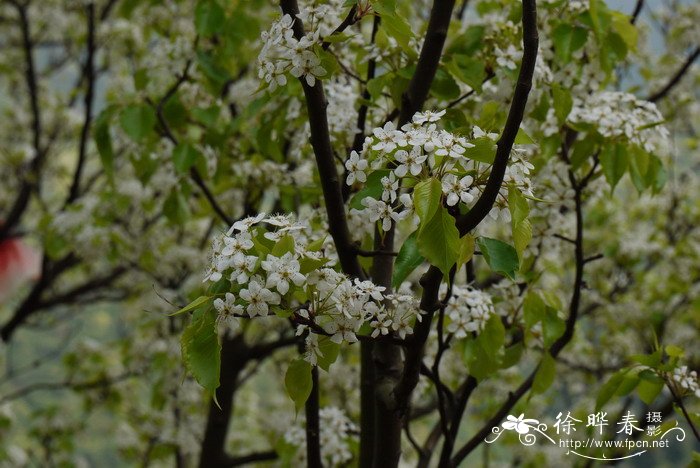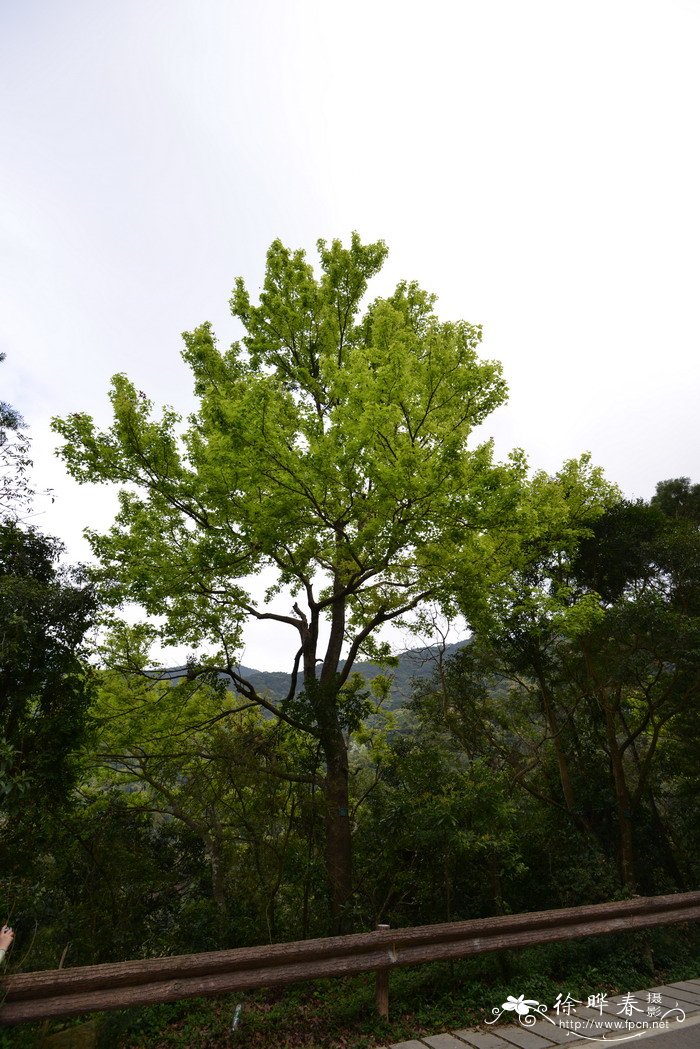豆梨Pyrus calleryana
中文名(Chinese Name):豆梨
学名(Scientific Name):Pyrus calleryana Dcne.
英文名(English Common Name):
别名(Chinese Common Name):糖梨、杜梨
异名(Synonym):Pyrus calleryana var. calleryana f. tomentella Rehder Pyrus taiwanensis H. Iketani et H. Ohashi Pyrus kawakamii Hayata Pyrus mairei H.L‚v. Pyrus calleryana var. dimorphophylla (Makino) Koidz.
科属(Family & Genus):蔷薇科Rosaceae梨属Pyrus
形态特征(Description):乔木,高5-8米;小枝粗壮,圆柱形,在幼嫩时有绒毛,不久脱落,二年生枝条灰褐色;冬芽三角卵形,先端短渐尖,微具绒毛。叶片宽卵形至卵形,稀长椭卵形,长4-8厘米,宽3.5-6厘米,先端渐尖,稀短尖,基部圆形至宽楔形,边缘有钝锯齿,两面无毛;叶柄长2-4厘米,无毛;托叶叶质,线状披针形,长4-7毫米,无毛。伞形总状花序,具花6-12朵,直径4-6毫米,总花梗和花梗均无毛,花梗长1.5-3厘米米;苞片膜质,线状披针形,长8-13毫米,内面具绒毛;花直径2-2.5厘米;萼筒无毛;萼片披针形,先端渐尖,全缘,长约,毫米,外面无毛,内面具绒毛,边缘较密;花瓣卵形,长约13毫米,宽约10毫米,基部具短爪,白色;雄蕊20,稍短于花瓣;花柱2,稀3,基部无毛。梨果球形,直径约1厘米,黑褐色,有斑点,萼片脱落,2 (3) 室,有细长果梗。花期4月,果期8-9月。
分布(Distribution):产山东、河南、江苏、浙江、江西、安徽、湖北、湖南、福建、广东、广西。适生于温暖潮湿气候,生山坡、平原或山谷杂木林中,海拔80-1800米。分布越南北部。
用途(Use):木材致密可作器具。通常用作沙梨砧木。
引自中国植物志英文版:FOC Vol. 9 Page 178
Pyrus calleryana Decaisne, Jard. Fruit. 1: 329. 1871.
豆梨 dou li | Rosaceae | Pyrus
Trees 5–8 m tall. Branchlets reddish brown when young, grayish brown when old, terete, initially tomentose, soon glabrescent, glabrous when old; buds triangular-ovoid, sparsely tomentose, apex shortly acuminate. Stipules caducous, linear-lanceolate, 4–7 cm, herbaceous, glabrous, margin entire, apex acuminate; petiole 2–4 cm, glabrous; leaf blade broadly ovate or ovate, rarely narrowly elliptic, 4–8 × 3.5–6 cm, glabrous, base rounded or broadly cuneate, margin obtusely serrate, apex acuminate, rarely acute. Raceme umbel-like, 6–12-flowered; peduncle glabrous; bracts caducous, linear-lanceolate, 0.8–1.3 cm, membranous, adaxially tomentose, margin initially glandular serrate, apex acuminate. Pedicel 1.5–3 cm; glabrous. Flowers 2–2.5 cm in diam. Hypanthium cupular, glabrous. Sepals lanceolate, ca. 5 mm, abaxially glabrous, adaxially tomentose, margin entire, apex acuminate. Petals white, ovate, ca. 1.3 × 1 cm, base shortly clawed, apex rounded. Stamens 20, slightly shorter than petals. Ovary 2(or 3)-loculed, with 2 ovules per locule; styles 2(or 3), nearly as long as stamens, glabrous basally. Pome blackish brown with pale dots, globose, ca. 1 cm in diam., 2(or 3)-loculed; sepals caducous; fruiting pedicel 1.5–3 cm, glabrous. Fl. Apr, fr. Aug–Sep. 2n = 34*.
Slopes, plains, mixed valley forests, thickets; 100--1800 m. Anhui, Fujian, Guangdong, Guangxi, Henan, Hubei, Hunan, Jiangsu, Jiangxi, S Shaanxi (Qin Ling), Shandong, Taiwan, Zhejiang [Japan, Vietnam].
The wood of this species is hard and close-grained, and is sometimes used for making furniture and stools. It is often used as stock to graft Pyrus pyrifolia.
Pyrus taiwanensis H. Iketani & H. Ohashi (J. Jap. Bot. 68: 40. 1993), described from Taiwan, might be an allied species or an ecotype of P. calleryana.




(责任编辑:徐晔春)
学名(Scientific Name):Pyrus calleryana Dcne.
英文名(English Common Name):
别名(Chinese Common Name):糖梨、杜梨
异名(Synonym):Pyrus calleryana var. calleryana f. tomentella Rehder Pyrus taiwanensis H. Iketani et H. Ohashi Pyrus kawakamii Hayata Pyrus mairei H.L‚v. Pyrus calleryana var. dimorphophylla (Makino) Koidz.
科属(Family & Genus):蔷薇科Rosaceae梨属Pyrus
形态特征(Description):乔木,高5-8米;小枝粗壮,圆柱形,在幼嫩时有绒毛,不久脱落,二年生枝条灰褐色;冬芽三角卵形,先端短渐尖,微具绒毛。叶片宽卵形至卵形,稀长椭卵形,长4-8厘米,宽3.5-6厘米,先端渐尖,稀短尖,基部圆形至宽楔形,边缘有钝锯齿,两面无毛;叶柄长2-4厘米,无毛;托叶叶质,线状披针形,长4-7毫米,无毛。伞形总状花序,具花6-12朵,直径4-6毫米,总花梗和花梗均无毛,花梗长1.5-3厘米米;苞片膜质,线状披针形,长8-13毫米,内面具绒毛;花直径2-2.5厘米;萼筒无毛;萼片披针形,先端渐尖,全缘,长约,毫米,外面无毛,内面具绒毛,边缘较密;花瓣卵形,长约13毫米,宽约10毫米,基部具短爪,白色;雄蕊20,稍短于花瓣;花柱2,稀3,基部无毛。梨果球形,直径约1厘米,黑褐色,有斑点,萼片脱落,2 (3) 室,有细长果梗。花期4月,果期8-9月。
分布(Distribution):产山东、河南、江苏、浙江、江西、安徽、湖北、湖南、福建、广东、广西。适生于温暖潮湿气候,生山坡、平原或山谷杂木林中,海拔80-1800米。分布越南北部。
用途(Use):木材致密可作器具。通常用作沙梨砧木。
引自中国植物志英文版:FOC Vol. 9 Page 178
Pyrus calleryana Decaisne, Jard. Fruit. 1: 329. 1871.
豆梨 dou li | Rosaceae | Pyrus
Trees 5–8 m tall. Branchlets reddish brown when young, grayish brown when old, terete, initially tomentose, soon glabrescent, glabrous when old; buds triangular-ovoid, sparsely tomentose, apex shortly acuminate. Stipules caducous, linear-lanceolate, 4–7 cm, herbaceous, glabrous, margin entire, apex acuminate; petiole 2–4 cm, glabrous; leaf blade broadly ovate or ovate, rarely narrowly elliptic, 4–8 × 3.5–6 cm, glabrous, base rounded or broadly cuneate, margin obtusely serrate, apex acuminate, rarely acute. Raceme umbel-like, 6–12-flowered; peduncle glabrous; bracts caducous, linear-lanceolate, 0.8–1.3 cm, membranous, adaxially tomentose, margin initially glandular serrate, apex acuminate. Pedicel 1.5–3 cm; glabrous. Flowers 2–2.5 cm in diam. Hypanthium cupular, glabrous. Sepals lanceolate, ca. 5 mm, abaxially glabrous, adaxially tomentose, margin entire, apex acuminate. Petals white, ovate, ca. 1.3 × 1 cm, base shortly clawed, apex rounded. Stamens 20, slightly shorter than petals. Ovary 2(or 3)-loculed, with 2 ovules per locule; styles 2(or 3), nearly as long as stamens, glabrous basally. Pome blackish brown with pale dots, globose, ca. 1 cm in diam., 2(or 3)-loculed; sepals caducous; fruiting pedicel 1.5–3 cm, glabrous. Fl. Apr, fr. Aug–Sep. 2n = 34*.
Slopes, plains, mixed valley forests, thickets; 100--1800 m. Anhui, Fujian, Guangdong, Guangxi, Henan, Hubei, Hunan, Jiangsu, Jiangxi, S Shaanxi (Qin Ling), Shandong, Taiwan, Zhejiang [Japan, Vietnam].
The wood of this species is hard and close-grained, and is sometimes used for making furniture and stools. It is often used as stock to graft Pyrus pyrifolia.
Pyrus taiwanensis H. Iketani & H. Ohashi (J. Jap. Bot. 68: 40. 1993), described from Taiwan, might be an allied species or an ecotype of P. calleryana.
(责任编辑:徐晔春)
踩一下[0]

顶一下[3]